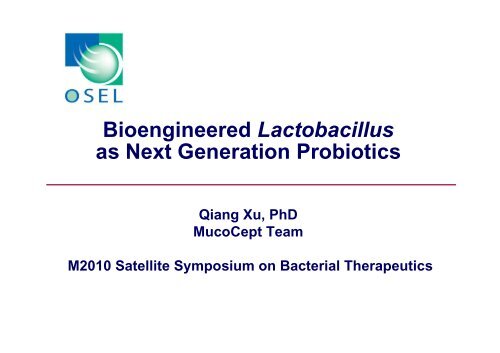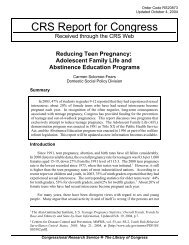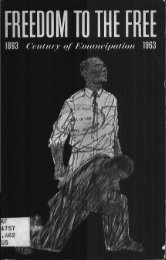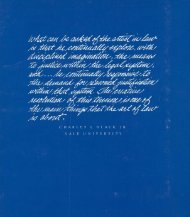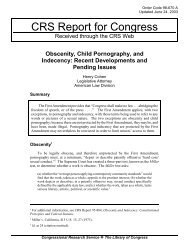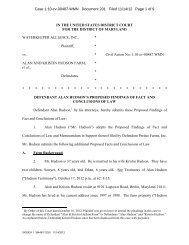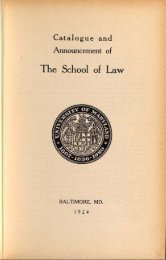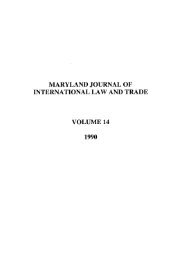Bioengineered Lactobacillus as Next Generation Probiotics
Bioengineered Lactobacillus as Next Generation Probiotics
Bioengineered Lactobacillus as Next Generation Probiotics
You also want an ePaper? Increase the reach of your titles
YUMPU automatically turns print PDFs into web optimized ePapers that Google loves.
<strong>Bioengineered</strong> <strong>Lactobacillus</strong><br />
<strong>as</strong> <strong>Next</strong> <strong>Generation</strong> <strong>Probiotics</strong><br />
Qiang Xu, PhD<br />
MucoCept Team<br />
M2010 Satellite Symposium on Bacterial Therapeutics
Strategy<br />
Commensal <strong>Lactobacillus</strong> species are<br />
important in host defense<br />
BV & STI’s are known cofactors for HIV<br />
transmission<br />
Our Strategy:<br />
• Select optimal human vaginal strains<br />
• Express potent HIV inhibitors at high levels<br />
• Develop technologies to preserve<br />
<strong>Lactobacillus</strong> <strong>as</strong> dry powder for ambient<br />
temperature storage<br />
• Promote high level and persistent vaginal<br />
colonization
Key Issues<br />
Colonization & competition with native flora<br />
In situ protein expression level & bioactivity<br />
Immunological responses<br />
Preservation of <strong>Lactobacillus</strong><br />
Bio-containment<br />
• Environmental survival<br />
• Strain transmission<br />
Regulatory hurdle for GMO
Strain Selection<br />
Primary screening in vitro<br />
• Bacterial identification (by 16S rDNA gene sequence)<br />
• H 2O 2 & lactate production, doubling time, aerotolerance<br />
• Endogenous pl<strong>as</strong>mid<br />
• Self-aggregation (a surrogate marker for in situ colonization)<br />
• Antibiotic resistance<br />
Secondary screening in vitro<br />
• Competition with commensal bacteria and mucosal pathogens<br />
─ Gardnerella vaginalis (& Candida albicans)<br />
• Susceptibility to possible <strong>Lactobacillus</strong> phages<br />
• Bacterial adherence in a human epithelial model<br />
Properties related to bacterial preservation<br />
• Carbohydrate fermentation profile<br />
• % of viable cells during fermentation and after drying<br />
• Vaginal colonization in a NHP model<br />
Suitability for genetic modification<br />
Cell banks made
Genetic Modification<br />
L. jensenii 1153 w<strong>as</strong> selected from >300<br />
human vaginal isolates of lactobacilli<br />
Expression c<strong>as</strong>sette [employing strong native<br />
promoters* and signal sequence (CbsAss)]<br />
integrated in the bacterial chromosome<br />
• *Verified in situ<br />
20 µm<br />
L. jensenii 1153<br />
(ptsH or rpsU)<br />
CbsAss Anti-HIV proteins<br />
Secreted<br />
RANTES derivatives<br />
Antibody fragments<br />
Virus entry inhibitors<br />
• Cyanovirin-N (P51G)
Cyanovirin-N (CV-N)<br />
& its Derivative<br />
A small acid-stable, monomeric protein (NCI)<br />
• A cyanobacterial protein – e<strong>as</strong>y to express<br />
• No post-translational modification site<br />
A potent HIV envelope-targeting inhibitor<br />
Retains activity in seminal pl<strong>as</strong>ma<br />
We expressed a modified version in<br />
<strong>Lactobacillus</strong><br />
• APVT-CV-N (P51G)<br />
• Same anti-viral activity<br />
• Low mitogenic potential<br />
kDa<br />
17<br />
14<br />
─ Low activation of CD25 or CD69<br />
6<br />
3<br />
CB staining<br />
Full-length
Additional<br />
in vitro Safety Evaluation<br />
Co-culture model of epithelial cells and CV-Nexpressing<br />
L. jensenii (Fichorova’s lab)<br />
• 1666, 2666, 3666: CV-N-expressing L. jensenii strains<br />
• 10 6 CFU/cm 2 of epithelial cells<br />
kDa<br />
17<br />
14<br />
6<br />
3<br />
17<br />
14<br />
6<br />
3<br />
wt<br />
Anti-CV-N pAb<br />
1666<br />
2666<br />
3666<br />
1646<br />
Malp2 50 nM<br />
No bacteria<br />
Vaginal cells<br />
APVT-CV-N<br />
Cervical cells<br />
APVT-CV-N<br />
Expressed CV-N<br />
binds to gp120<br />
No evident<br />
upregulation of<br />
proinflammatory<br />
markers by the<br />
cervicovaginal<br />
epithelium<br />
Raina Fichorova, Oral presentation for Abstract # 355
Vaginal Colonization<br />
in NHP<br />
A key issue for safety and efficacy, prior to<br />
human dosing<br />
Establishment of Chinese rhesus macaque<br />
model (Yu et al., 2009)<br />
• Harbor endogenous vaginal <strong>Lactobacillus</strong>, mostly H 2O 2producing<br />
L. johnsonii<br />
• Allow clearance of vaginal <strong>Lactobacillus</strong> with<br />
azithromycin, and restoration of endogenous L.<br />
johnsonii colonization<br />
• Support persistent colonization of a human vaginal<br />
isolate of L. jensenii at 10 5 -10 7 CFU per vaginal swab<br />
collected<br />
Collaboration with Dean Hamer (NCI), ABL, SRI,<br />
Brigitte Sanders-Beer (BIOQUAL)
Vaginal Colonization<br />
in NHP<br />
CV-N-<strong>Lactobacillus</strong>* dosed vaginally using hydroxyethyl cellulose (HEC)<br />
<strong>Lactobacillus</strong> recovered<br />
(CFU/vaginal swab)<br />
10 8<br />
10 7<br />
10 6<br />
10 5<br />
10 4<br />
10 3<br />
Macaque 3539 Macaque 3567<br />
3 10 17 24 40 87 3 10 17 24 40 87<br />
Number of Days After Bacterial Inoculation<br />
*Tested in >20 Chinese rhesus macaques
In Situ CV-N Expression<br />
Assayed by<br />
Collection of CVL by 2× 2-ml w<strong>as</strong>hes<br />
CV-N detected by Western blots<br />
Time post inoculation<br />
0 hr<br />
24 hr<br />
Week 3<br />
Week 6<br />
CV-N<br />
control<br />
Lj 1153-1666 Lj 1153-2666<br />
M1 M2 M3 M4 M5 M6<br />
NHP<br />
In situ expressed<br />
full-length APVT-<br />
CV-N (P51G)<br />
binds to gp120
Immunogenicity<br />
Anti-CV-N antibodies (ELISA Signal)<br />
2.5<br />
2<br />
1.5<br />
1<br />
0.5<br />
0<br />
No evident immunogenicity against CV-N<br />
B<strong>as</strong>eline<br />
8/11/2009<br />
8/18/2009<br />
9/1/2009<br />
10/5/2009<br />
10/12/2009<br />
10/26/2009<br />
11/16/2009<br />
11/23/2009<br />
7 inoculations<br />
4/14 - 4/28<br />
6 re-inoculations<br />
9/22 - 9/29<br />
M3730 M3559 M3567 M3579 rabbit anti<br />
CV-N<br />
serum<br />
Non-diluted Chinese rhesus macaque CVL samples<br />
Similarly, no antibodies against L. jensenii were detected<br />
1:3000<br />
1:6000<br />
1:12000<br />
1:24000<br />
1:48000<br />
1:96000<br />
1:192000
Regulatory Considerations<br />
Environmental Persistence<br />
• No persistence in the environment<br />
Genetic Stability<br />
• The engineered strain is genetically stable<br />
Bacterial Transmission<br />
• No sexual transmission of L. jensenii from female to<br />
male macaques, n=2<br />
Availability of Rescue Therapy<br />
• Engineered <strong>Lactobacillus</strong> contain no antibiotic<br />
resistance marker<br />
• Engineered <strong>Lactobacillus</strong> cleared from colonized<br />
macaques using azithromycin <strong>as</strong> vaginal suppository
<strong>Lactobacillus</strong> Manufacture<br />
Issues:<br />
Cell viability<br />
Cell recovery upon rehydration<br />
Appropriate bacterial dosage form<br />
Shelf life at room temperature storage<br />
Focus:<br />
Fermentation<br />
Formulation & preservation<br />
Bacterial dosage<br />
Poster Presentation, Abstract # 241
Formulation & Preservation<br />
Fermentation optimization<br />
B<strong>as</strong>ic preservation matrix<br />
• Trehalose, skim milk, and an antioxidant (sodium <strong>as</strong>corbate)<br />
• Transient buffering<br />
Production of highly viable <strong>Lactobacillus</strong><br />
• By freeze (or spray) drying<br />
• >10 10 colony-forming units (CFU)/100 mg powders<br />
Preservation Matrix Components<br />
B<strong>as</strong>ic matrix<br />
(skim milk, trehalose, phosphate buffer, sodium <strong>as</strong>corbate)<br />
Live/total ratio*<br />
upon drying<br />
16%<br />
B<strong>as</strong>ic matrix + polyol + 2nd antioxidant 32%<br />
Skim milk; 2x trehalose; 2x phosphate buffer; 2x sodium<br />
<strong>as</strong>corbate; 2x polyol; 2x 2nd antioxidant<br />
* live/total ratio=CFU per ml/total cells per ml<br />
>90%
<strong>Lactobacillus</strong> Powder Delivery<br />
Vaginal administration to 6 macaques<br />
• Dried powder in capsule vs. reconstituted in 1.0 ml MRS<br />
Vaginal swabs collected 3 and 10 days after final<br />
bacterial inoculation<br />
<strong>Lactobacillus</strong> recovered<br />
(CFU/vaginal swab)<br />
10 8<br />
10 7<br />
10 6<br />
10 5<br />
10 4<br />
10 3<br />
10 2<br />
10 1<br />
3 days post-inoculation 10 days post-inoculation<br />
Reconstituted<br />
in MRS<br />
Capsule<br />
New dosage forms/delivery are being explored<br />
Collaboration with Brigitte Sanders-Beer (BIOQUAL)<br />
10 8<br />
10 7<br />
10 6<br />
10 5<br />
10 4<br />
10 3<br />
10 2<br />
10 1<br />
Reconstituted<br />
in MRS<br />
Capsule
Current Focus<br />
Conduct pre-IND consultation with FDA on the use<br />
of bioengineered <strong>Lactobacillus</strong><br />
• Evaluate vaginal colonization, clearance, and biocontainment<br />
in human volunteers (Ph<strong>as</strong>e 0)<br />
─Use of bioengineered <strong>Lactobacillus</strong> with a<br />
surrogate marker (β-glucuronid<strong>as</strong>e)<br />
• Working with the MIP R33 Team<br />
Expand the platform, along with our lead program<br />
• Co-express HIV inhibitors (single or multiple strains)<br />
• Develop multipurpose microbicides against other STIs<br />
• Mucosal delivery of antigens<br />
Confirm bioactivity of in situ-expressed proteins<br />
Refine dosage forms/delivery to promote more<br />
efficient vaginal colonization
Studies in Progress<br />
by Other Investigators<br />
CV-N-expressing <strong>Lactobacillus</strong> strains in yogurt for<br />
feeding and gut CV-N expression<br />
• Bharat Ramratnam<br />
Alpaca antibodies to inhibit HSV by targeting<br />
integrins<br />
• Richard Markham<br />
Mannose binding <strong>Lactobacillus</strong> <strong>as</strong> anti-HIV strategy<br />
• Lin Tao<br />
Antiviral factors from <strong>Lactobacillus</strong><br />
• Ruth Ingrid Connor<br />
<strong>Lactobacillus</strong> on genital HIV shedding<br />
• Jane Hitti<br />
And more…
Acknowledgements<br />
NIH U19 AI60615 (PO: Drs. Jim Turpin/Roberta Black)<br />
NIH U01 AI066708 (PO: Dr. Carolyn Deal/Jonathan Glock); MIP II, MIP IV (PO: Dr. Turpin)<br />
USAID funding through IPM; CONRAD Foundation/GMP; GATES Foundation GCE<br />
Xiaowen Liu<br />
Yang Liu<br />
Rosa Yu<br />
Laurel Lagenaur<br />
Peter Lee<br />
Thom<strong>as</strong> Parks<br />
Kimberly Smith<br />
Qing Xia<br />
Letong Jia<br />
Wenjun Huang<br />
Former<br />
colleagues<br />
External Collaborators:<br />
Bioqual, Inc., Brigitte Sanders-Beer<br />
Southern Research Institute, Carol Lackman-Smith, James Cummins<br />
Advanced Bioscience Laboratories, Inc., Deborah Weiss, Jim Treece<br />
University of Pittsburgh, Sharon Hillier, Lorna Rabe<br />
Brigham and Women’s Hospital, Raina Fichorova<br />
UCSF, Craig Cohen, Anke Hemmerling<br />
University of W<strong>as</strong>hington, Dorothy Patton, Yvonne Cosgrove Sweeney<br />
NIH, Dean Hamer, E. Berger, A. Gronenborn, S. Rao, Mario Roederer<br />
CDC, Laura Barrientos, University of South Alabama, Lewis Pannell<br />
NCI, Barry O'Keefe; CAMI & UC-Berkeley, Bethany Young Holt<br />
IPM, Joe Romano, David Fairhurst<br />
LBL, Broad Institute, JCVI<br />
Stanford University, Gary Schoolnik, Mark Holodniy<br />
Planned Parenthood Mar Monte, Jill MacAfee<br />
Aaron Diamond AIDS Research Center, David Ho<br />
San Raffaele Institute, Paolo Lusso, Luca Vangelista<br />
Profectus Biosciences, Timothy Fouts, Antony Dimitrov<br />
Chinese CDC, Zhiqing Zhang


